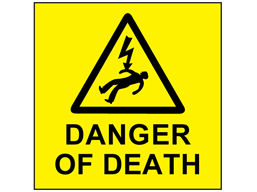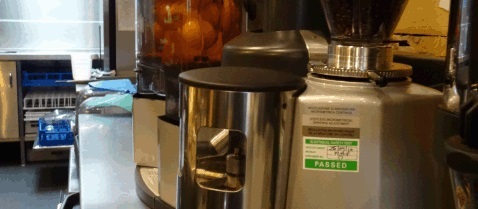Electric shocks cause thousands of serious injuries each year in the UK alone - even those who are lucky enough to escape electrocution (death by electric shock) can still end up suffering from burns, persistent pain, heart/respiratory problems, and numerous other consequences.
For this reason, it's extremely important that everyone does their bit to minimise the risk posed by electrical hazards. If you are responsible for managing premises that contain such hazards, it is your duty to inform those around you of the danger. This is best achieved through the use of electric shock notices: signs and labels that warn of potentially lethal electrical installations.

Here are some examples of how electric shock notices can be deployed to protect people's safety:
- Generic electrical warning signs should be placed near any electrical hazards
- If the specific voltage is known, it's a good idea to identify this with an appropriate label or sign
- An electric shock treatment guide may help to save a life if an incident does arise
- Electric shocks can often be prevented using the correct PPE (Personal Protective Equipment) - put up PPE signs to remind people of this
Click here to browse Label Source's complete range of electrical notices, signs and labels.

Here at Label source, we provide a huge range of electrical labels that will help you take the steps for identifying the risks and hazards of electricity and greatly reduce the likelihood of an accident.
Every year thousands of people are severely injured or killed because of accidents involving electricity. A lot of these accidents could have been prevented with the implantation of electrical warning labels; due to the very nature, and unpredictability of electricity not all of these accidents are not completely preventable. This is why it is so important that you take the correct steps to provide warnings to your employees or visitors of any electrical hazards they may encounter in your workplace.
Contact with electricity can cause devastating effects, from shocks, which can lead to falls from height, to painful burns and in the worst cases, death. The type of accident the contact causes is dependent on the voltage of the electricity. Coming into contact with a voltage as low as 50v can cause a person to have a cardiac arrest, or prevent them from breathing.
To help prevent electrical accidents in the workplace it is crucial that you are testing your machinery, equipment and even office tools such as computers, monitors and even your kettle to ensure that they are safe to use. In the event that you do find that some of your equipment is unsafe, make sure you shut it down immediately and use one of our plant maintenance electrical labels to inform every one of the machines status.
We take electrical safety extremely seriously here at label source, and we hope that you do too. This is why we have a whole department dedicated to electrical labels. Our electrical labels have been designed to highlight the hazards and dangers of live electrical equipment. These electrical labels will help mark the following electrical hazards; High voltage, Connections, Power supplies, Live wires, and safety signs. Click here to view our electrical label department
We supply a comprehensive range of electrical labels, including a variety of specific electrical signs, however, if you cannot find the exact label that you are looking for please don’t hesitate to contact us or call a member of our customer service team on 0800 3761 693

It is of vital importance that every electrical appliance and piece of equipment is properly tested, in order to ensure the safety of those who are using it. While some safety defects can easily be identified visually, there are others which only become apparent when the items are thoroughly examined and tested.
The Electricity at Work Regulations legislation, states that any item with the potential to cause injury should be maintained, and kept in a safe condition. While the law does not state how frequently these items should be checked in order to guarentee safety, it stands to reason that regular use should go hand in hand with regular checks.
A record or label can be extremely useful for the monitoring and maintenance of electrical items, which is why we stock a wide range of PAT Test Stickers here as Label Source. These can be used by professional PAT testers to help them complete their tasks more efficiently, and are compliant with all relevant legislation, including that which we have previously mentioned.
Our PAT test range includes equipment labels, plug stickers, cable wraps and record cards; all intended to give a clear and easy-to-read indication of when the item was tested, and what the outcome was. The labels cover a wide array of purposes, from periodic inspection, to earth continuity/leackege checks and insulation resistance testing. These items are essential to both the tester and the user, as they keep a clear visual record of items which are unsfe and should not be used.
If you would like to view our full range of PAT test monitoring items, you can click on the link highlighted above to purchase high-quality safety labels that are fit for your intended purpose. For more advice and information about our labels, or if you can't find what you're looking for, call us on 0800 3761 693 (UK) or 0044 1443 842769 (International). Alternativley you can email your questions to sales@labelsource.co.uk, and we will aim to respond as quickly as possible.
Electricity is extremely dangerous; even small appliances need to be clearly labelled to prevent shocks and minimise the risk of electrocution.
We at Label Source offer an extensive range of laminated voltage labels for electrical supplies and other high-voltage installations/appliances. Here are some examples of what we have to offer people and business who are serious about electrical safety:

Voltage-Specific Labels
Many of the voltage stickers we stock give specific voltages (e.g. 110V, 440V), making them ideal for applications that require an accurate voltage measurement.

Non-Specific Voltage Stickers
If you do not know the exact voltage of the installation you are labelling - or if you would simply prefer to send a stronger message to those who may be exposed to this electrical hazard - we also sell a variety of voltage labels with more general warnings and information (e.g. 'High voltage', 'Danger of death').

Labels for Specific Installations
Many of our voltage labels are design to be used alongside specific hazards, such as live busbars or terminals.
No matter what kind of hazard you're labelling, our wide range of voltage stickers is sure to have something to suit your requirements. Click here to browse our full collection.
Electrical Safety Month is nearly over, but that doesn't mean we should stop thinking about electrical hazards and the harm they can cause. Electrical safety should be a continuing concern for everybody (especially employers, who must always take responsibility for the health and safety of their workers).
With that in mind, we'd like to close Electrical Safety Month with these helpful tips for preventing electrical accidents:
- Only carry out electrical work if you are competent enough to do so. Not all electrical jobs have to be carried out by qualified electricians - for example, most people are capable of changing a light bulb or replacing the fuse in a plug. However, you should NEVER undertake ANY electrical work unless you are completely sure of what to do; if you don't know the correct way to safely complete the task at hand, call someone who does.
- Pay attention to warning signs and labels. If you see an electrical warning sign or safety label, be sure to heed its instructions before continuing. Those warnings are there for a reason!
- Provide warning signs and labels for others. Of course, electrical safety warnings don't magically appear on any potentially hazardous equipment - they have to be put there by a responsible person. If that person is you, be sure to use the correct signs and labels to help protect your employees and the general public from harm.
- If you see something unsafe, report it. It could be an electrical installation that isn't properly labelled, a cable that has become unfit for us, or even a co-worker carrying out electrical work in an improper manner - whatever the hazard, be sure to let somebody know. Report it to the person responsible for health and safety in your workplace, and if they don't take action, contact the Health and Safety Executive for further guidance. You should never stay quiet about a potential safety risk - inaction costs lives!
- Educate yourself and others. It's easier to prevent electrical accidents if you know exactly what can happen. For starters, we recommend visiting the HSE's Electrical Safety page and brushing up on the do's and don'ts of electrical work. Be sure to share the information with others, too - you won't be able to keep everyone safe on your own!